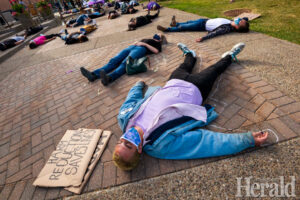‘Die-In’ marks closure of SCS
By Jensen, Randy on September 1, 2020.
 Brady Gleeson, along with other demonstrators, takes part in a "die-in" Monday at city hall protesting the closure of the supervised consumption site. Herald photo by Ian Martens
@IMartensHerald
Brady Gleeson, along with other demonstrators, takes part in a "die-in" Monday at city hall protesting the closure of the supervised consumption site. Herald photo by Ian Martens
@IMartensHeraldTim Kalinowski
Lethbridge Herald
tkalinowski@lethbridgeherald.com
To mark International Overdose Awareness Day supporters of harm reduction held a “Die In” protest at Lethbridge City Hall and a candlelight vigil at the former supervised consumption site to draw attention to local overdose victims.
At the same time, protesters on the Piikani Nation held a memorial walk to remember those who have died of overdoses in their community, and called for more action to help prevent other deaths.
In Lethbridge the focus of the “Die In” was the final closure of the ARCHES-run supervised consumption site on Monday, with those coming out expressing their fears more people would die in the community now that the SCS was closed. About 100 harm-reduction advocates came out for the event.
Moms Stop the Harm, a group of mothers whose children are either addicted to drugs or have died from overdoses, helped organize the Die In protest and vigil.
“This is a very somber day for those who have lost people to addiction,” said Moms Stop the Harm representative Lori Hatfield, “or who have people who are struggling, and to those family members that don’t have that family member around anymore. My son lives with addiction. He is in recovery right now.”
“Addiction is a mental-health issue,” she stressed. “It is not a political issue. Even though he is in recovery now, this will be with him for the rest of his life. And it’s a fight he is going to have to fight every day. Relapse is part of recovery, and if services here are cut off and throughout the province it just makes people more vulnerable to overdoses if they relapse.”
Hatfield noted that on this day set aside internationally to raise awareness of overdose deaths the SCS in Lethbridge was being shut down by decisions made by the UCP government.
“They have used the platform of what happened at ARCHES as a reason to close it, but I think that has just been the scapegoat of their overall plan,” she said. “That’s my personal belief. They should have brought (outside) management immediately to take over when they discovered this. An investigation could have been done, but they did not need to shut down the service.”
Hatfield expressed her belief the new mobile overdose prevention site (OPS) would not be able to handle the volume needed in the community for harm-reduction services, leading to more overdose deaths in Lethbridge.
“Logistically the mobile site will not be able to take on the numbers that were accessing the supervised consumption site,” she stated. “The numbers were 600 to 800 visits a day at the SCS as opposed to the three chairs they have available at the mobile unit, of which they can only put two in at a time due to COVID.”
Another attendee at the Die In at city hall, Sam Mackey, said without ARCHES, and the support she received from the organization while fighting her addiction, she wouldn’t be alive today and wouldn’t be in recovery. She started coming to the organization when she was just 18 years old when she was a local addict living on the streets and eventually began working with the organization to help others like herself.
“We have a real epidemic here,” she said, speaking from experience. “People are really dying. This is what is happening.”
Mackey said she hoped the new OPS mobile unit would help save lives and that Lethbridge residents would be compassionate enough to look out for those experiencing overdoses to try to help when they can.
“It’s a bit of a terrifying thought,” she said when asked about meeting the harm-reduction needs of the community in light of the closure of the ARCHES SCS. “We have a lot of work ahead of us. Thankfully, we do have the OPS. They are having to do the best work they can, and I have no doubt they will do that. However, it’s kind of liking closing a hospital and leaving an ambulance.”
At Brocket, demonstrators took part in a memorial walk and signed a 75-foot banner demanding more action on local overdose deaths to mark International Overdose Awareness Day.
Diana Northpeigan lost her youngest son Rudy to an overdose in June, and has a daughter in treatment for addiction at the Bringing Home the Spirit Home detox centre in Standoff.
Northpeigan says her community’s government and its institutions are failing them.
“It broke me when it happened,” she said, speaking about her son’s death. “It’s going on 10 weeks now, but everyday it’s the why? What could I have done? Or how could I have prevented losing him? That’s why I got on board with the overdose awareness day here in Piikani, because there are not enough prevention measures to help us to save another life (in the community). In close proximity to my son’s death, we had three others back to back within a week. We had four deaths from overdoses, and they were probably all from the same drug dealer.”
Northpeigan says Piikani lacks qualified addictions experts, lacks services to help drug addicts looking for immediate treatment, and has too much cronyism in the local health-care system which puts relatives in jobs they are not qualified for.
“What I would like to see come out of this (action) today is our chief and council put qualified workers into those positions that are needed here on our reserve, and to have more compassionate workers who want to help to the best of their abilities,” she stated. “There are a lot of closed doors now because of COVID, but those doors were closed long before COVID as well. Only certain families were helped. What I am trying to do is open the doors for everybody; so we are all treated the same É We’re going to continue failing in Indian country because there is too much of, ‘There’s my relative. I am going to give them a job.’ Instead of hiring that lady nobody knows, and who knows what she is doing.”
Northpeigan hopes the message she and others were sending on International Overdose Awareness Day was getting through to the decision-makers.
“The hardest thing is to know that my daughter has come open about her drug use only after she lost her brother,” Northpeigan stated. “My son, I never knew he had the problem. But right now I have my daughter who is in detox at the Kainai healing centre. She is now on her way to go for treatment. But I couldn’t even get that help on my own reserve.”
Follow @TimKalHerald on Twitter
27-26




